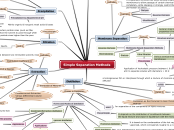Simple Separation Methods
Crystallization
Used to
obtain pure material in the crystalline state.
oncentrating a solution containing the component of interest by
heating it
allowing it to stand
Optimal solvent composition
s designed to minimize contamination of the crystals with other materials.
Membrane Separation
Definition
It a separation process that utilize semipermeable membranes to allow passage of certain chemical species completely, while stopping or strongly restrict the permeation of others.
Some Applications
Convert salt water to drinkable water
Removal of urea from blood
Separate azeotropic mixtures
Examples
Ultrafiltration
Dialysis
Reverse Osmosis
Methods
Structure and properties
General important properties of membranes
Good mechanical stability
Good chemical stability.
Various semipermeable membranes
Microporous Membranes
Used to
Separate particles that differ significantly in size.
The principle
If the size of particles (or molecules):
>>pores sizes -> rejected to pass
<< pore size -> allowed to pass
intermediate pore size -> partially rejected
Homogeneous Membranes
Composition
a homogeneous film or interphase through which a mixture of chemical species can be carried by molecular diffusion
The principle
Particles of exactly the same size can be separated with homogeneous diffusive-type membranes when their solubilities in the film or their concentrations differ significantly
Thin Membranes
The thinner the membrane; the faster the transport rates through membranes.
Charged Membranes
The principle
The separation is accomplished by:
pore size as well as
exclusion of coions (ions of the same charge as
The fixed ions) from the membrane
Membrane-Based Separation Methods
Ultra filtration
The process
Application of hydrostatic pressure between 1 & 10 atm to separate solutes with diameters > 20 Aْ
Reverse Osmosis
Dialysis
Electrodialysis
Evaporation
Usage
As a first preparation step for further separation.
As final step for obtaining an isolated material as a residue
Methods
Using an open container for a period of time
Application of heat
example
evaporation of seawater to get sea salt salt (NaCl)
Definition
t is the process of removing the solvent from a sample by heating or by utilizing air currents which lead to concentrate the sample or transfer it into a solid state.
Precipitation
formation of precipitate (PPT)
By Increase the concentration of a solute in a solution to a higher level than its solubility
formation of pure crystals
By carried out in (a proper solvent & a controlled manner)
Methods
Solvent Precipitation
Addition of another miscible solvent to the solution which lower the solubility of the component of interest
Precipitation via Chemical Reaction
Addition of a species that form a lower solubility salt with the target species.
Common ion effect
Precipitation by Adjustment of pH
Mainly organic & inorganic weak acids & bases
Filtration
The principle
Porous material with a certain particle sizes (such as filter paper or membranes) allow the solvent to pass through while retaining the solids with particle sizes higher than the pore sizes.
used to
separate solids from liquids.
Types of filtration
Filtration under vacuum
Using Buchner funnel
Using Membrane Filters
Simple filtration
Using simple filter papers (made from cellulose) and exhibit particle retention levels down to 2.5 μm.
Using gravitational force to separate solids from the liquid.
Extraxtion
Definition
Distribution of solute between two immiscible solvents
Distribution Coefficient Kc
Distribution of a solute concentration (C) between two solvents ( 1 and 2) during extraction can be represented by the following equation: Kc = C1/C2
Distribution Coefficient of a Species
Distribution Coefficient is used for one species.
Distribution ratio D
Excluding all complications according the interactions between the extracted species and the used solvents; these interactions should be ignored to simplify the calculations. D = total concentration of solvent in organic phase/total concentration of solvent in aqueous phase
Successive Extractions
If Kc >1000 -> 1 signal extraction stage is enough to extract all of the target species.
If Kc < 1000 -> divide some of the extraction solvent into smaller portions and for each portion use successive extractions.
Extraction of Mixtures
Multiple Extractions
Craig Apparatus
method of multiple liquid-liquid extractions is countercurrent extraction, which permits the separation of substances with different distribution coefficients (ratios)
Countercurrent Extraction Versus Differential Column System
Distillation
related to
evaporation but all the components of interest are volatile. while volatile components are separated from non-volatile ones in evaporation.
solids
sublimation (highly specialized distillation method), is used to volatilize their component if possible .
Phases in Distillation
used
for separation of the components of liquid mixtures.
The principle
It depends on the distribution of constituents between
the liquid mixture and vapor in equilibrium with the mixture.
more volatile components concentrated in the vapor
less volatile ones are in greater concentration in the liquid.
Forms and Modes of distillation
Fractional distillation
It is based on the condensation of the hot vapor at verious levels in the column and the resulting liquid refluxes to a lower level where it is vaporized, which corresponds roughly to a re- distillation.
Flash distillation
It is instantaneous and continuous vaporization of a definite fraction of the liquid mixture in such a way that the total vapor produced is in equilibrium with the residual liquid.
vacuum distillation
It is distillation under decreased pressure to reduces the boiling temperatures.
Applications
To separate
high-boiling mixtures.
materials that decompose below their normal boiling points.
steam distillation
The mixture boiling point tempreture is reduced by vaporixing it into a stream of carrier vapor
Azeotropic/Extractive distillation
Any technique used to break an azeotrope (mixtures that are difficult to separate) in distillation.
The process
Adding another component to alter the relative volatility of the mixture substances and form lower-boiling azeotrope that is heterogeneous.
Applications
To separate mixtures whose components boil too close together for economic fractional distillation.
Example
Formation of two immiscible liquid phases by addition of benzene to water and ethanol.
Distillation as the Precursor to Gas Chromatographic Methods
volatile components
separated on a packed or capillary column
non- volatile components
HPLC
